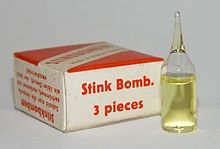Stink bomb
A stink bomb today is essentially a joke that spreads gases with an extremely unpleasant smell in the immediate vicinity. However, these gases are harmful to health at higher doses . If it is used as a means of sabotage and dispersal, it is to be assessed as a chemical weapon in terms of its mode of action and the risk potential .
Hydrogen sulfide stink bomb
An inexpensive and easy-to-make type of stink bomb is the hydrogen sulfide stink bomb, which gives off the typical odor of rotten eggs. The gas responsible for the foul odor is hydrogen sulfide, which is also produced when proteins are broken down, but which is highly toxic in higher concentrations.
In this stink bomb shape, the gas is released through the reaction of iron sulfide (Fe II S) in the form of a fine powder with hydrochloric acid, which is usually supplied in a glass ampoule .
The products of the reaction are iron chloride (FeCl 2 ) and the foul-smelling gas hydrogen sulfide. Educts can also contain other sulfur-containing substances such as B. ammonium sulfide or ammonium hydrogen sulfide , as well as stable inorganic acids such as sulfuric acid or phosphoric acid . Inconsistent acids such as carbonic acid are not recommended, as these mostly break down into water and the gas used for production in the slightly exothermic reaction.
The reaction of other sulfides with acids proceeds according to the following scheme:
The positively charged cation of the sulfide attracts the negatively charged acid anion, while the negatively charged sulfide anions form an atomic bond with the hydrogen ions of the acid to form hydrogen sulfide . The quantitative ratio varies depending on the number of charges of the cation and the number of protons (hydrogen ion number) of the acid.
Butyric acid stink bombs
In addition to hydrogen sulfide, butyric acid is also used to produce inexpensive, particularly effective and long-lasting stink bombs . The penetrating odorous substance is also used to drive away animals with a fine sense of smell, such as moles.
German-speaking area
A standard stink bomb usually consists of a small, breakable glass ampoule filled with a foul-smelling substance. A common version contains hydrogen sulfide , which is dissolved in water as a carrier substance and which gasses out after breaking the glass ampoule. The glass splinters pose a risk of injury.
In Germany , stink bombs based on ammonium sulphide , ammonium hydrogen sulphide and ammonium polysulphides are prohibited according to Section 3 of the Consumer Goods Ordinance.
In Austria , according to Section 18 of the Pyrotechnics Act of 1974, the “import, transfer, possession and use of pop corks and stink bombs” is prohibited.
In addition to stink bombs in glass ampoules, aerosol cans filled with a foul-smelling gas are also sold today. The contents of these spray cans are suitable to prepare a room accordingly, whereby no glass splinters arise. However, the application is not as quick and not as punctiform as is the case when throwing a glass ampoule. Such spray cans are commercially available under the name “Fart Spray” or “Pups Spray”.
Stink bomb in the USA
In the USA in particular, the stink bomb was also used as a means of sabotage and business damage. Stink bomb attacks were made in the 1920s and a. in Cleaners and Dyers War in Detroit used to the laundries to sabotage competitors.
Before z. B. Eugenio Giannini began his career as an illegal businessman of the underworld, he worked as a guardian in high society restaurants in New York City . One of his duties was to protect the guests from harassment; In particular, this included preventing stink bombs from being thrown into restaurants, which was frequent at the time.
Stink bombs were also used to scatter groups of people and to counter demonstrations by security forces and police in the USA.
Web links
- US Military Is Seeking Ultimate "Stink Bomb" . Bijal P. Trivedi on January 7, 2002; National Geographic News at news.nationalgeographic.com (English)
Individual evidence
- ↑ Appendix 1 to Section 3 of the Consumer Goods Ordinance
- ^ The Cleaners and Dyers War ( January 8, 2006 memento in the Internet Archive )


